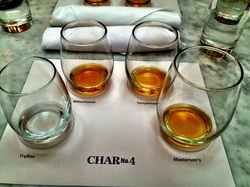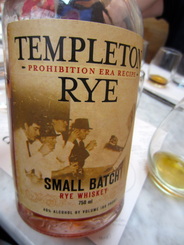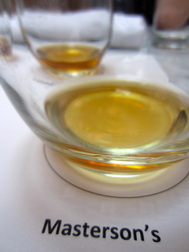 Rainy Saturday afternoons are becoming my favorite Whiskey Time. This weekend’s found me around the corner in Char No. 4 on Smith Street for a class on Rye. Our instructor, Allan Roth, referred to it as the “Gateway Whiskey” on the way to the harder bourbon and Scotch. I think maybe I skipped over it for Scotch and have now found myself seeking to know more about it. Apparently, I caught it at a good time since there has been a Rye Revival of sorts, thanks to the resurgence of cocktails and a rise in craft distilleries. But Rye, according to Allan, has deep American roots – the Whiskey Rebellion was over Rye, George Washington was a distiller of Rye, and the American cocktails like Old Fashioneds and Manhattans center around it.  We approached it straight – with 125 proof, unaged TryBox Rye New Make. It’s clear and straight off the still, but would grow up to be Rittenhouse Rye if it slept in a barrel for a few years. Most of the unaged whiskey I have tried is corn whiskey and it isn’t my favorite, but for purposes of understanding the basic taste of a Rye whiskey, this worked. It still has plenty of corn, with a very grainy taste and the smell of pure alcohol. Having Rittenhouse Straight Rye Whiskey 100 proof after the unaged whiskey showed how key the barrel flavor really is – and the benefits of having the barrel pull out the bad flavors while imparting the charcoal sweetness to the whiskey. Rittenhouse uses whiskey aged 8 to 10 years. I’ve enjoyed this one straight before, but Allan said bartenders like it for cocktails since its strong taste holds up to the mixers.  At 80 proof, Templeton Rye came off softer and sweeter. The myth from the website is that this was Al Capone’s favorite whiskey, which could be true, but the company that revived the Templeton Rye label also happens to use whiskey from a distillery in Indiana that once belonged to Seagrams, which used the whiskey as one of the components for Canadian whiskey – a process that pairs a strong base spirit with a lighter flavoring whiskey. Which I guess works out – Al Capone spent a lot of time trying to get Canadian whiskey into the US. We ended on Masterson’s, which is distilled over 10 years, more delicate and smooth with a citrus flavor. It uses Colorado water and is bottled in California and tailored to what Allan called the “California palette” – what happens when people in wine country make whiskey. Goodness happens, apparently. I liked Rye more than I realized. And you can’t help learning about it without learning a little about American history. Note to US history teachers – a little whiskey really livens up the lessons. Comments are closed.
|
Archives
November 2017
|

 RSS Feed
RSS Feed
